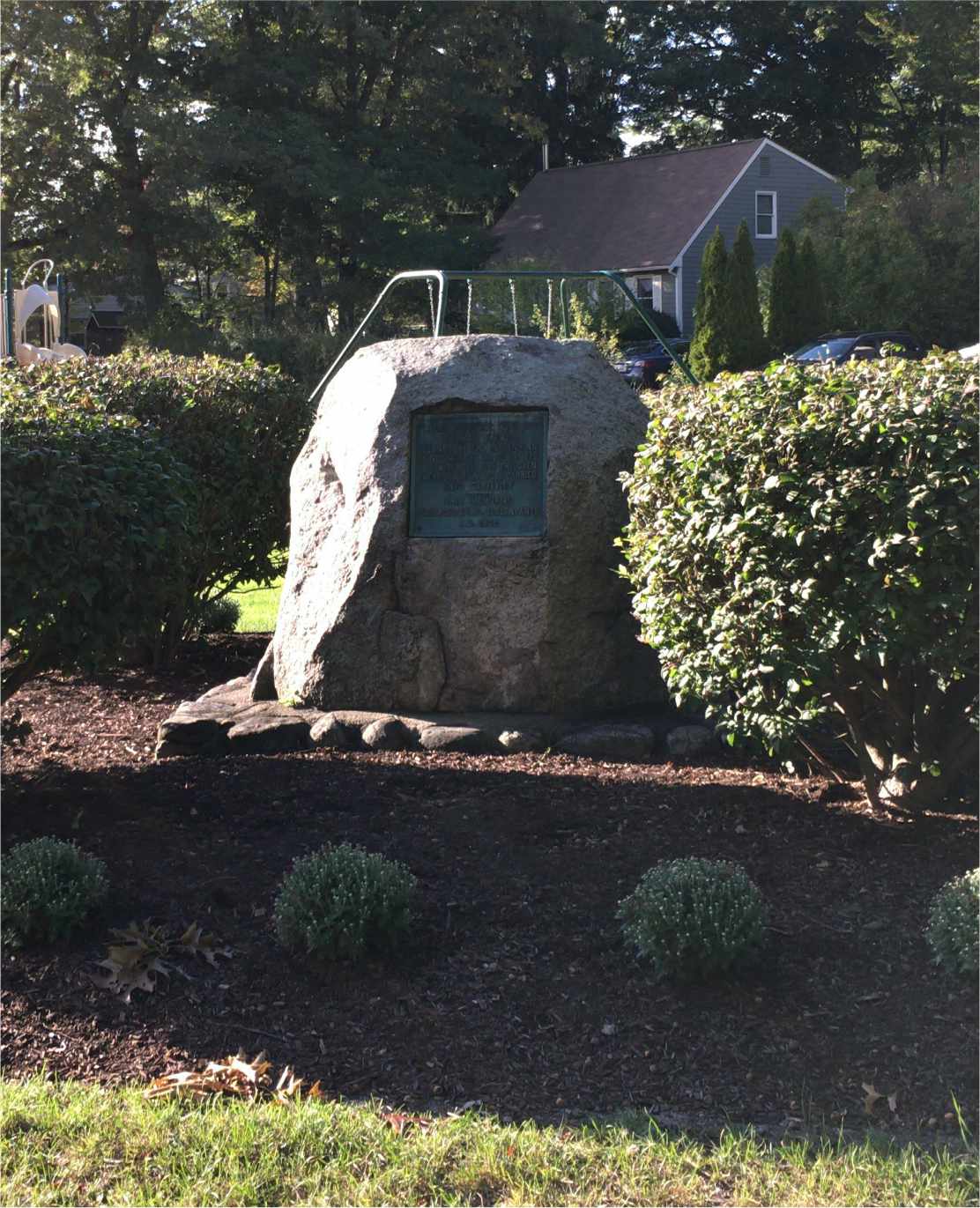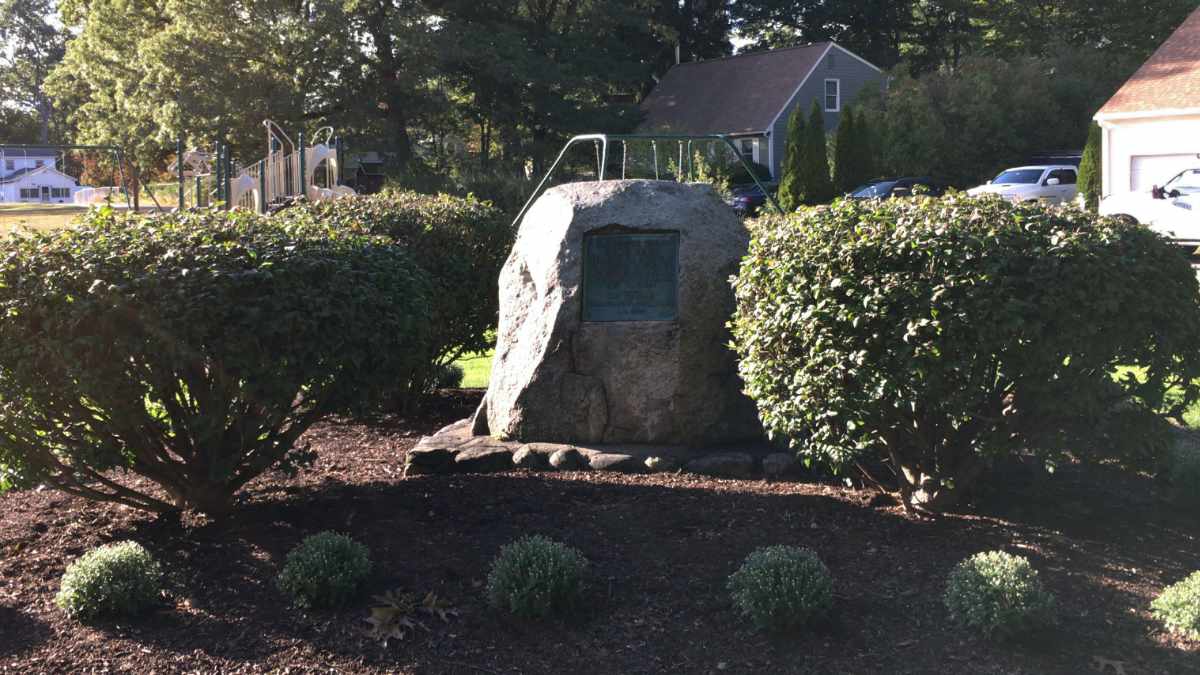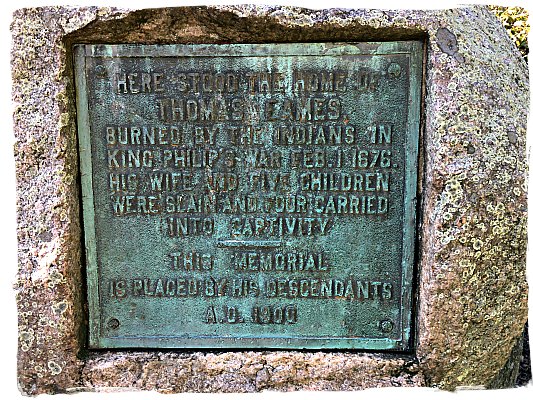The Eames Massacre Monument
Monument to those that lost their lives in Framingham
In Framingham, near the corner of Chautauqua Ave and Mt. Wayte Ave, lies a monument to a horrific incident that occurred 340 years ago. In 1676, during King Philip's War, a mother and children were killed defending their home that was attacked by Indians.
This would be known as The Eames Massacre.


History of the Thomas Eames Family
In 1618, Thomas Eames was born in England. He came to Massachusetts Bay around 1634 and did some odd jobs. In 1637, he fought in the Pequot War.
After the Pequot war, Thomas married Margaret and settled in Dedham around 1640. They had three children John and Elizabeth. (The first John died before reaching age one.) Margaret died on September 17th, 1660.
In 1662, Thomas married Mary Paddleford and moved to Wayland. Mary was a widow and had four children from a previous marriage: Mary, Johnathan, Zachariah, and Edward. They had three additional children together: Thomas Jr., Samuel, and Nathaniel.
How they got the Framingham Farm
Thomas wrote a letter to the government of Massachusetts Bay and asked for land as a reward for his service in the Pequot War. His request was denied, but the request caught the attention of Deputy Governor Thomas Danforth. He gave a small part of his vast land to the Eames family.
The Eames farm was isolated from other families in the area. According to colonial document records, there were only seven families in the Framingham area. Most of the other family farms were together in the northern part of the town.
Tension between the Colonials and the Indians
King Philip's War (1675-1676) was an armed conflict between Native American inhabitants of present-day New England and the English settlers. The battle was seen as the last chance effort to remove the English settlers from New England.
In the summer of 1675, Massachusetts Bay provided four soldiers to secure the Framingham area. By the fall, there were no new attacks in the region, and the council in Boston couldn't justify the cost of the troops and decided to bring the troops back to Boston.
In January 1676, word got around that surrounding towns were at risk of being attacked by Indians. Thomas Eames took action and traveled to Boston to get ammunition and military help to protect his family.
February 1, 1676 - The Eames Massacre
While Thomas was away, eleven Indians attacked the house and farm. His wife Mary defended herself using hot soap. She was quickly overpowered and was killed along with five other children. The remaining children were taken into captivity and the house and barn were burned. Horses and livestock were stolen.
Results of the attack
| Mary Eames | 30 | Killed |
| Zachariah Paddleford | 18 | Captured and Escaped |
| Edward Paddleford | 15 | Killed |
| Thomas Eames Jr. | 12 | Killed |
| Samuel Eames | 11 | Captured and Escaped |
| Margaret Eames | 9 | Captured and Ransomed |
| Nathaniel Eames | 7 | Captured and Escaped |
| Sarah Eames | 5 | Killed |
| Lydia Eames | 3 | Killed |
Zachariah, Samuel, Margaret, Nathaniel all returned to Framingham after escaping from capture.
At the time of the attack, Thomas was very weak and on disability. It's possible that he could have been killed as a result of the attack.
Aftermath
Investigation into the attack and the identity of the Indians were uncovered: Netus, Anneweaken, Aponapawquin, Acompanatt, Panananumquis, William Wannuckhow, Apumatquin, Pumapen, Awassaquah, and Aquitekash.
Thomas Eames put together an inventory of the loss of items. The General Court granted him some monetary compensation for 200 acres of land as well as 200 acres of Indian land.
Much of the land become downtown Framingham and part of Ashland.
All the Indians that participated in the event were captured or were killed while trying to be captured. Some of the Indians were executed and others were sold off as slavery.
Thomas died in 1681 in Framingham, less than five years after the massacre.
Rock Monument
In the early 1900s descendants of Thomas Eames put a rock monument at the location of the former homestead. The monument reads:
Here stood home of Thomas Eames Burned by the Indians In King Philips War February 1, 1676 His Wife and Five Children Were Slain and Four Carried Into Captivity This Memorial Is Placed by his Descendants A.D. 1900

Missing Sign
In 1930, another sign was placed on the site, just behind the plaque on the rock. It has since gone missing from the site.
The sign read:
"While Thomas Eames sought help from Boston on February 1st, 1676. The Indians attacked his house which stood nearby. His wife and five children were slain and four children captured."
